HINDUISM
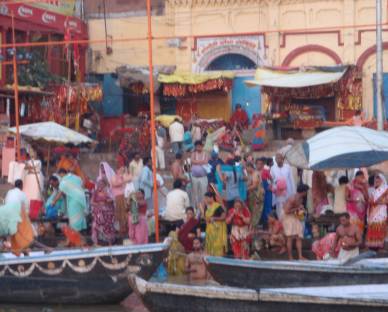
The Ghats in Varanasi
Around 1500 BC, a people commonly known as Aryans, who were probably migrants from Central Asia, settled in what is now India. A Sanskrit text of that period, the Rig Veda, describes the worship of nature gods such as fire and rivers. Over the next 500 years, further Sanskrit treatises, the Upanishads, described a philosophical quest for truth through enquiry. They also described a social structure based on a caste system and prescribed sacrifices and rituals to appease the gods. These early beliefs eventually morphed in to Hinduism. Given the antiquity of these Sanskrit writings, Hinduism is usually considered the oldest religion of those still being practiced.
Hinduism lacks a single body of scripture. In addition to the Rig Veda and Upanishads, it also refers to the two epics – the Mahabharta and Ramayana.
The beliefs of Hinduism are complex, but some knowledge of its basic tenets helps the non-Hindu appreciate its symbolism. There are three aspects of Hinduism that seem particularly unique to most Westerners – polytheism, reincarnation, and the caste system.
There are three primary Hindu gods. They are Brahma, Vishnu, and Shiva: Brahma is the creator, Vishnu is the preserver, and Shiva is the destroyer. Almost all Hindus worship Vishnu or Shiva or some manifestation of them, and there are many manifestations.
Hindus believe in reincarnation. They believe that one whom leads a good life will return in a better incarnation, and one whom does not lead a good life returns in a worse life (karma). By leading consistently better lives, one can eventually reach moksha which is the release from the cycle or rebirth.

Steps at the Ghats in Varanasi
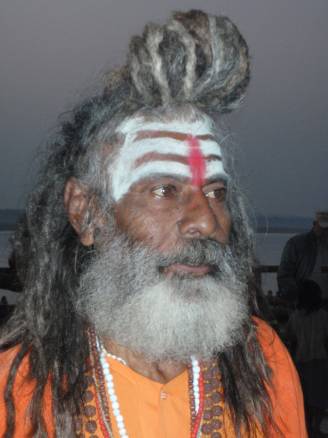
Hindu Ascetic
Hindus also cling to the caste system despite it being technically illegal. The caste system is less rigid in urban centers, but it persists in rural areas in which more than 70% of Indians reside. It was originally related to one’s occupation, but it has long since degenerated in to a system of inherited discrimination – sometimes called ‘India’s hidden apartheid’. One’s caste is a hereditary characteristic that one can never improve. One cannot move to a higher caste during their present lifetime. Social structure and families remain stratified by caste. There are four primary castes: brahmins are teachers and priests; kshatriyas are politicians and landowners,; vaishyas are farmers, merchants, and businessmen; and shudras are servants and laborers. There are also many sub-castes within each caste.
Hinduism is the world’s third largest religion after Christianity and Islam. Hinduism has approximately one billion followers worldwide, and more than ninety percent live on the Indian sub-continent.
Hinduism pervades life on the sub-continent, and we were able to experience it in a variety of settings from small rural villages to ancient temples. We were fortunate to be there during their festival of Diwali which is a colorful celebration of Rama’s return to Ayodhya after 14 years in exile as told in the epic Ramayana.
Varanasi is also known as Kashi, or the City of Light. It is located on the west bank of the Ganges, and it is India’s holiest Hindu city. Its spiritual and religious legacy dates back almost 3,000 years.
There are more than 700 temples in Varanasi, but none is more sacred than the river itself. The Ganges is worshipped as a living goddess, and the faithful can cleanse their sins through ritual immersion in the river. Daily baths are reported to prepare the soul for its final journey to liberation. Thousands make this ritual dip daily at sunrise and sunset.
More than 4 miles of river bank is lined with ghats, temples, and shrines. Nearly all of this area is filled with the faithful washing clothes, performing yoga, offering flowers and incense, or taking their ritual dip.

Colorful crowd in Simaria taking a dip in River
We went out on the river in a small rowboat at sunrise and sunset to watch the rituals. One is most struck by the numbers of people and how colorful they are. The shore is awash in crowded color. There is constant prayer, cremation, and celebration. But neither the crowds nor the color is restricted to the river banks. Walking around the ghats and riding bicycle rickshaws inland reveal the same crowded color blended with shopkeepers, priests, and food hawkers.
Varanasi, as India’s holiest Hindu city, is probably the single best snapshot of Hindu life in India. It is, however, a bit overwhelming, and we looked forward to seeing Hindu life in more remote and sedate villages.
Kalna is a relatively small town of just over 50,000 population on the west bank of the Bhagirathi River. It is the site of numerous remarkable Hindu temples – the Krishna Chandraji Temple, the Pratapeswar Temple, and 108 Siva Temples among others.
The Krishna Chandraji Temple was built from 1751 to 1755. It has an elongated verandah with three arched entrances, and it is decorated with ornate terracotta plaques.
The Pratapeswar Temple was built in the 19th century, and it is a curvilinear sikhara design. It is very heavily ornamented with decorative terracotta plaques.
The 108 Siva Temples was built in 1809 by Maharaja Teja Chandra Bahadur. It is two concentric circles of small individual temples – each containing a lingum. There are 74 temples in the outer ring and 34 in the inner ring.

Krishna Chandraji in Kalna
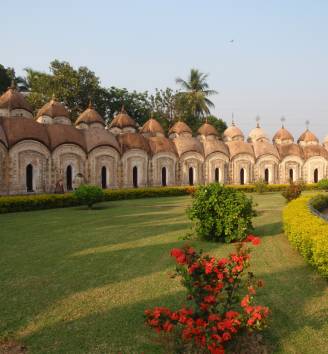
108 Siva Temples in Kalna
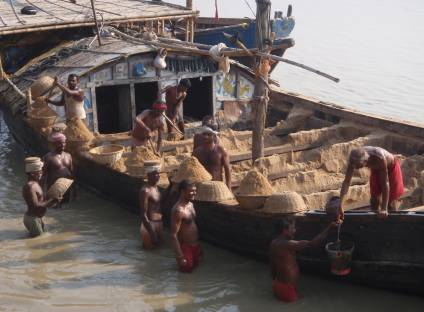
Mining sand in Chinda
And on a smaller scale, we also visited various Hindu towns and villages along the rivers. Among others, we visited Chinda, Simaria, Matiara, and Kumaratulli.
Chinda was a small and very rural village where most make their living by sand mining – very difficult work. We just walked through the village and took in the atmosphere.
Simaria is a small village in the Begusarai district in Bihar state. They were having their annual ‘fair’, and it was a whirlwind of activity. There were areas of camping sites and areas of merchants, and we never did figure out what the fair was celebrating. However, the people were very friendly, and they seemed to enjoy our visit.
Matiara is a small village where many make their living with traditional methods of brass work. We saw the smelting process then visited a traditional brass worker whom shapes and engraves his work by hand.
Kumaratulli is not a town or village per se, but it is a traditional potters’ area in northern Kolkata. We went there the day before the beginning of the four day long Durga Puja. Craftsmen were busy finishing countless pottery statues of the goddess Durga. Durga means ‘invincible’, and the goddess Durga is the fierce demon-fighting aspect of Parvati, Shiva’s consort. Statues ranged in size from a few inches to twenty-five feet. Most were headed to the river where they would be offered, submerged, and set free over the next few days.
From these places, and others, we think that we experienced a fair glimpse in to the day-to-day world of the Hindu in India. We know that our exposure was only a small glimpse, but we found it a vibrant, colorful, and exciting world – even if a bit confusing.
Follow us to our look in to Buddhism or return to our land travel page.
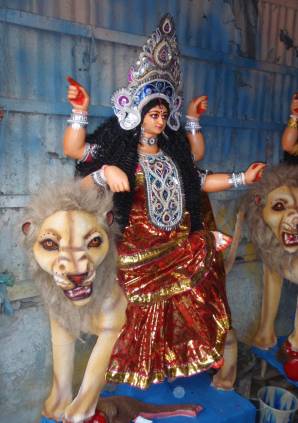
Life-size goddess statue